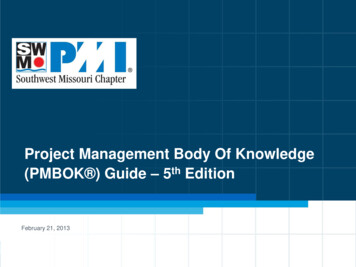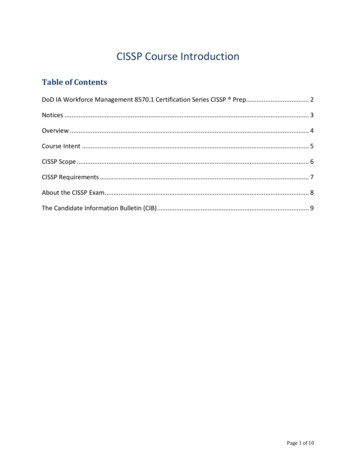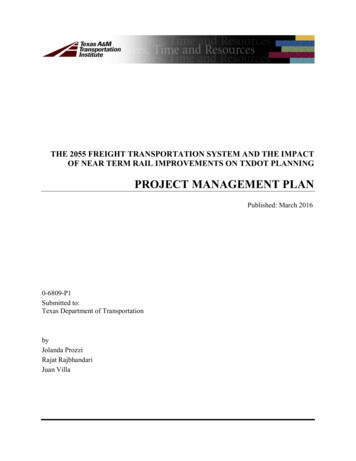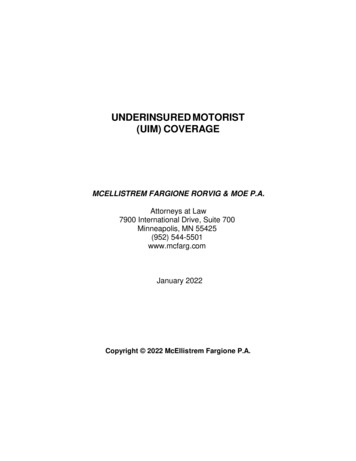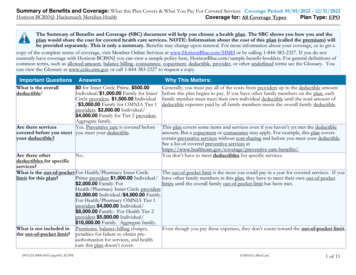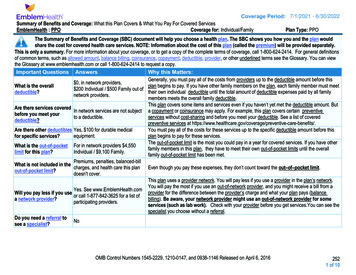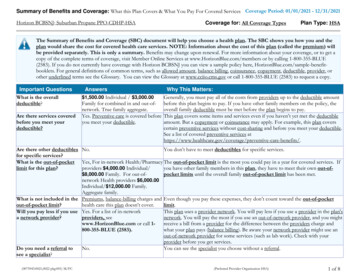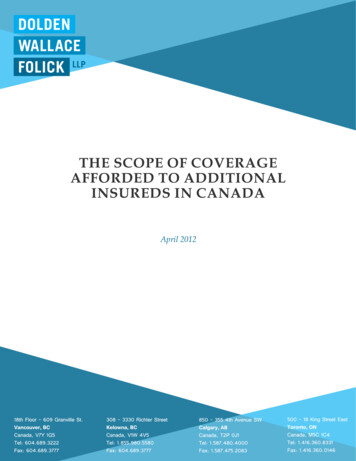
Transcription
THE SCOPE OF COVERAGEAFFORDED TO ADDITIONALINSUREDS IN CANADAApril 2012 Dolden Wallace Folick LLP1
The Additional Insured Endorsement in CanadaA.IntroductionThe past five years have seen a surprising amount of litigation concerning the issue ofwhat insurance coverage is extended to insureds who are added to a liability policy byway of an Additional Insured Endorsement. Courts in British Columbia and Ontariohave led the charge, releasing a series of decisions which, while attempting to provideguidance, have left both insurers and their counsel with only a modest ability to predicthow they might extend or limit coverage in the future.Lease agreements, facility rental agreements, and a variety of other contractualarrangements often provide that one party will agree to indemnity and obtain insurancefor another party. The insurance, when obtained, is often provided through nothingmore than an indication on a ‘Certificate of Insurance’ that a party has been added as anadditional insured, usually with the restriction that coverage is extended, but only withrespect to the operations of the named insured.Let us consider a not-so-uncommon situation which faces a liability insurer:A woman slips and falls on a walkway leading to a parking lot. Her fall was caused, shesays in part, by "the presence of ice and snow on the surface of the walkway." She sustainsinjuries and sues several defendants, including the parking lot operator and its snowremoval contractor. The parking lot operator, in turn, cross-claims against its snowremoval contractor on the basis of the "indemnity" and "insurance" provisions in theirsnow removal agreement, and seeks coverage under the contractor’s liability insurancepolicy, having been added as an additional insured, “but only in respect of liability arisingout of the [operator’s] operations”. To what extent is the additional insured entitled tocoverage under the Named Insured’s policy, and in particular, will the policy respondto provide coverage to the parking lot operator for their own negligence?The purpose of this paper is to explore the jurisprudence in Canada as it pertains to thescope of coverage which is available to additional insureds and to identify the problemsassociated with the manner in which Canadian courts have extended, or confined, thatcoverage. Dolden Wallace Folick LLP
B.The Additional Insured EndorsementLet us initially consider the different terms pursuant to which additional insureds arepurported to have coverage under a liability policy.A common extension of coverage pursuant to an Additional Insured Endorsement mayprovide:This Form includes the party or parties named in the Declarations as anAdditional Insured but only with respect to the operations performed by or onbehalf of the Named Insured. Such insurance as is afforded by this Extension doesnot insure liability arising out of the operations of the Additional Insured or itsemployees.Alternatively, coverage may be afforded to an Additional Insured through a formwhich extends coverage to the additional insured,but only with respect to liability arising out of the activities of the named insured.We also find reference to wording such as:[parties] have been added as additional insureds, but only with respect to theirinterest in the operation of the named insured.Despite the variations in wording as noted above, courts surprisingly remain focusedon one main consideration in determining whether coverage is extended to theadditional insured: whether a claim can be said to be “arising out of” the namedinsured’s operations. In other words, despite the fact that the endorsement may use theterm “arising out of”, Canadian courts ‘hone’ in on the nature of the connectionbetween the claim and the operations of the named insured.C.The Scope of Coverage available to Additional InsuredsAs with all things in life, the situations in which courts have faced the issue of whatcoverage is extended to an additional insured are varied. As will become clear from thecaselaw which is discussed below, the issue of whether an additional insured is entitledto coverage, and the nature of the coverage that is afforded, is highly fact specific.Minor differences in pleadings (and indeed I would argue negligible differences) canlead to completely different results. Dolden Wallace Folick LLP2
(a) The Ontario ApproachIn Dominion of Canada General Insurance Company v. ING Insurance Company of Canada1,Intact Insurance (ING), insured the operators of a banquet hall pursuant to a generalliability policy. Dominion of Canada insured the owner of the building.The plaintiff was injured in the parking lot adjacent to the banquet hall after slipping onice. A lease agreement between the banquet hall operator and the building ownerprovided that the building owner was responsible for the maintenance of the parkinglot. The ING policy provided that the building owner was an additional insured, but“only with respect to liability arising out of the ownership, maintenance or use of that part of thepremises.leased to" the banquet hall.The issue before the application judge was whether the additional insured endorsementin the ING policy was broad enough to provide coverage to the building owner. Uponapplication in first instance, the judge found that the building owner was entitled tocoverage under the ING policy. Interestingly, the application judge determined that,although the lease agreement arguably would not have included the parking lot as“premises”, she instead turned to the definition of “premises” located in theCommercial Building and Contents Broad Form section of the ING policy to infer thatthe area in which the slip and fall occurred was “premises” for the purpose of theadditional insured endorsement.On appeal to the Divisional Court, ING argued that the application judge had erred indetermining that the “premises” included the parking lot, and further argued that theaccident was not causally connected to the banquet hall, but arose out of the negligentconditions in the parking lot.The Divisional Court agreed with ING and the appeal was allowed, noting that "theparties cannot have intended that insurance coverage for the landlord would be extended to coverinjuries caused by the use of other areas of the property that the landlord was required tomaintain."2 The court specifically indicated:9The Application Judge concluded that the definition of "premises"contained elsewhere in ING's policy included the place where Mr. Greco wasinjured. She found that the definition of premises in the lease between Vitullo andGreco as not of much assistance because of the specific definition of "premises" inthe policy. In doing so, she erred.122011 ONSC 3841Ibid., para. 14 Dolden Wallace Folick LLP3
10The Application Judge used the definition of "premises" found in FormBF02, the Commercial Building and Contents Broad Form section of the INGpolicy (at p. 142 of the Appeal Book). That definition was on its face clearlyrestricted to Form BF02 and does not apply to the policy as a whole.11In our opinion, the Application Judge also erred in failing to give propereffect to the words of the endorsement limiting coverage to "liability arising out ofthe ownership, maintenance or use of that part of the premises designated in theDeclaration Page(s) leased to the Named Insured" (emphasis added). In order todetermine whether there was insurance coverage, it was necessary to firstdetermine the part of the premises that was leased to the named insured, and thento determine whether liability of Vitullo "arose out" of the ownership,maintenance, or use of those leased premises.12Although the description of the demised premises contained in the leasewas not as clear as might be wished, the demised premises clearly did not includeany area of Vitullo's property outside of the banquet hall itself. When the lease isread as a whole, it is evident that the lease was for the interior space, althoughPremier was allowed to use the parking area under certain conditions.***14The respondent nevertheless argues that Vitullo's liability arose out of theuse of the banquet hall, as Mr. Greco was leaving the hall when he was injured inthe parking lot. The Application Judge appears to have come to that conclusion,although she was acting under the conclusion that "premises" was as definedelsewhere in the policy to mean "the entire area within the property lines .".15In our opinion, the words "arising out of . the use of the premises" in theING policy requires a causal connection between the injury to Mr. Greco and thepremises demised, that is the banquet hall.3In Riocan Real Estate Investment Trust v. Lombard General Insurance Co.,4 Riocan operatedtwo mall properties in Sault Ste Marie and was a defendant in two actions whereplaintiffs had sought damages for personal injuries arising out of separate slip and fallincidents. Riocan had contracted with Palmer Paving, requiring Palmer to providesnowclearing services for the parking lots. Those contracts further provided thatPalmer would indemnify Riocan for losses suffered as a result of anything arising from34Ibid., paras 9-12; 14-15(2008), 91 O.R. (3d) 63 (SC) Dolden Wallace Folick LLP4
the work performed by Palmer under the contract. The contractor was also required tomaintain a contract of insurance and to name Riocan as an additional insured. Lombardinsured Palmer for these contracts and named Riocan as an additional insured.The court noted:[14]Each of the underlying actions alleges negligence against the ownerspecifically for failing to properly maintain the parking lot free of ice and failing tosalt or sand. The failures alleged in these claims could be attributable to thefailure of the contractor to perform its obligations under the contract. Theseclaims, if proven, would fall within the policy coverage and would thereforetrigger a clear duty to defend Riocan as a name insured with respect to the workunder the contract.[15]However, in each of the actions, there are also claims asserting breaches ofRiocan’s statutory obligation as an occupier. The contractor’s insurance coveragedoes not cover Riocan’s own negligent acts or breaches of the Occupiers’ LiabilityAct. For these claims the duty to defend Riocan is not independently triggered.[16]Notwithstanding the multiple theories pleaded by the plaintiffs, thefundamental issue raised in each of the actions is that the plaintiffs’ slip and fallon the ice covered parking lot occurred because of the failure of the owner to keepthe parking lot free of ice. The true nature of the claim is that the defendant wasnegligent in failing to maintain an ice-free parking lot and as a result theplaintiffs fell and sustained injuries.Summarizing the issue of whether the Lombard policy would have to respond, evenwhere there were allegations which may fall outside of coverage, the judge noted:I am of the view that in most situations where there is a duty on an insurer todefend some, or only one, of the claims made against an insured and that claimembodies the true nature of the claim, a duty to defend the entire claim arises.This is so even where the pleadings include claims that may be outside the policycoverage. Conflict issues can be addressed in a number of ways.Another case that recently that recently focused on the phrase “arising out of” was theOntario decision Lacombe v. Don Phillips Heating Limited and Francis Fuels Ltd.5 Here, theplaintiffs’ sought damages which were alleged to have resulted from oil spill at theirresidence in 2003. The plaintiffs allege that, in the winter before the oil spill, they hiredthe defendant Francis to replace the plaintiffs’ oil furnace. Francis, in turn,52005 CanLII 33036 (ONSC) Dolden Wallace Folick LLP5
subcontracted with the defendant Don Philips Heating Limited (“Phillips”) to run anew fuel oil feed line to the tank from the furnace. Shortly thereafter, the plaintiffsnoticed the smell of fuel.Aviva, in addition to being the plaintiffs’ insurer, was also Phillips’ liability insurerunder this separate policy. Under this policy, Francis was an additional namedinsured. The endorsement adding Francis as an additional named insured limitedcoverage to Francis “solely with regard to liability arising out of the operations of the namedinsured”. Aviva denied coverage on the basis that the loss arose out of independentoperations of Francis, namely failing to inspect following installation of the furnace.In the course of determining what coverage would be available to Francis, the courtnoted:“The term “arising out of” has a broader significance than “caused by”. In Amosv. I.C.B.C. [1995] 3 S.C.R. 405 (S.C.C.), at para. 21, the Supreme Court ofCanada held that the words “arising out of” have been said to mean “originatingfrom”, “having its origin in”, “growing out of”, “flowing from”, “incident to”, or“having connection with”. So long as Francis’ liability has any connection to theactions of Phillips coverage will be available.” (emphasis added)***In order to avoid coverage, the Court held that the insurer had to “draw a clearline between the actions of the [Named Insured] and the [Additional Insured]”,which had not been done. There was no claim against the [Additional Insured]that was completely independent of the actions of the Named Insured. Hence,coverage was available to the Additional Insured in the circumstances.In other words, the court construed the term “arising out of” very broadly in this case.In Harris v. Memorial Boys’ & Girls’ Club Inc.,6 the plaintiff was injured after using ahorizontal bungee amusement at the London Rib Fest. She brought an action againstthe amusement operator, the company which she thought owned the amusement, theMemorial Boys’ and Girls’ (“the Club”) which operates the Rib Fest and the City ofLondon (“the City”) as owner of Victoria Park. The City brought an application seekingto recover its share of the settlement paid to the plaintiff from the Club’s liabilityinsurer.The Club’s liability insurer provided coverage to the City as an additional insured “butonly with respect to their interest in the operations of the named insured.” The court, in6[2008] O.J. No. 2750 (QL)(SCJ), Dolden Wallace Folick LLP6
concluding that the City was entitled to coverage under the Club’s liability policy, thecourt noted:[29] Having considered the foregoing, I have concluded that the City is entitledto indemnity from the Club for any contribution it made to settlement with theplaintiff. I recognize that Clause 4 of the Rental Agreement makes it clear thatcare, custody and control of Victoria Park and equipment remains with the City.In my view, the term “equipment” necessarily refers to City property and notequipment brought in by users of the Park given the exclusion in the concludingwords of the clause. That clause is to be read together with Clause 5 which statesthat “the applicant will indemnify and save harmless the City against all loss,costs, claims, damages, actions, suits of any nature and kind whatsoever whichmay arise as a result of the use of the facility” [emphasis added]. There is nothingambiguous about this clause and it is certainly very broadly worded, sufficientlyso, in my view, to require the Club to indemnify the City in the circumstances ofthis case.[30] I do not consider it necessary to determine whether the indemnity clause issufficiently broad to cover any negligence on the part of the City. I respectfullyagree with the decision in Potvin but would distinguish it from the facts of thiscase. The plaintiff’s injuries here were causally connected to the activities beingcarried out by the Club and its vendor in the park. There is, therefore, aproximate connection between the injury and the use of the park by the Club. Itseems to me that the plaintiff’s injury is closely connected to the activity that theClub’s insurer agreed to insure. Ms. Harris would not have been injured but forthe Club’s decision to put on the Rib Fest. (emphasis added)One should contrast the decision in Harris with the conclusion of the court in Waterloo(City) v. Economical Mutual Insurance Co.7 The plaintiff, attended at annual Oktoberfestparade, was injured by a passing train. The parade was organized and operated by KW Oktoberfest Inc. The City of Waterloo had been added as an additional insured onK-W Oktoberfest’s insurance policy with Economical.The additional insured endorsement stated:This insurance applies to those stated on the declarations as “additionalinsureds”, but only with respect to liability arising out of the operations of thenamed insured.The court, in holding that Economical’s policy was not obligated to respond, noted:7[2006] O.J. No. 5252 (QL)(SC) Dolden Wallace Folick LLP7
In my view this is a common, clear and unambiguous limitation of coverage. Thewords “arising out of” have been interpreted in the cases to include suchmeanings as “originating from”, “growing out of”, “flowing from”, “incidentto”, or “having connection with”.These words define the pertinent liability for which coverage is provided. Thepleadings on their face do not allege facts in support of liability “flowing from”or “incident to” the operations of K-W Oktoberfest Inc. And the plaintiffs havenot sued K-W Oktoberfest Inc. The K-W Oktoberfest parade was merely the siteor occasion of the Hepditches unfortunate accident with the train.All of the allegations of negligence against the City stand alone and are neitherexpressly or by necessary inference derivative of or arising out of the operationsof K-W Oktoberfest Inc.Tinkess v. N.M. Davis Corp.,8 is an example where the Ontario court interpreted thewords “arising out of” narrowly. Indeed, the fact situation initially posited in theintroduction to this paper was exactly the situation faced by the court in Tinkess. Theplaintiff slipped and fell on a walkway leading to a parking lot. Her fall was caused,she alleged, by “the presence of ice and snow on the surface of the walkway.” She sustainedinjuries and sued several defendants, including the parking lot operator and its snowremoval contractor. The parking lot operator, in turn, cross-claims against its snowremoval contractor on the basis of the “indemnity” and “insurance” provisions in theirsnow removal agreement.As the court noted, “the issue that arises on this motion is whether the snow removalcontractor is contractually required to defend and indemnify against all claims, including thoseinvolving the parking lot operator’s negligence or just the claims arising out of its ownnegligence.”9The agreement between the snow removal contractor and the parking lot operatorprovided:“7. Indemnity/Hold Harmless Agreement. Parkway shall not be liablefor any injury or damage to any person or property whatsoever byreason of, or in any manner arising out of, any of [Total’s] acts orfailures to act under or pursuant to the Agreement. [Total] shallindemnify, defend, with counsel acceptable to Parkway and hold89[2007] O.J. No. 1026 (QL)(SCJ)Ibid., para. 3 Dolden Wallace Folick LLP8
harmless Parkway and its affiliates from and against any and allclaims arising from the acts or failure to act of [Total] inconnection with the matters governed by this Agreement ”“8.Insurance. [Total] shall at its own cost and expense carry commercialgeneral liability insurance (including insurance against assumed orcontractual liability under this Agreement) with a minimumcombined single limit of one million dollars and naming Parkwayand its affiliates as additional insureds ”10The snow removal contractor argued that the “indemnity agreement,” required thecontractor to indemnify the parking lot operator’s acts of negligence (or failures to act)but does not require the snow removal contractor to indemnify the operator for theoperator’s own acts of negligence.In essence, the snow removal contractor argued that the contractual right to indemnityand defend only applies where the claim being made against the operator arises fromthe allegedly negligent acts of the contractor, not those of the operator. As for theinsurance obligation, the contractor argued that section 8 simply “mirrors” the liabilityset out in section 7 – “that is, the operator is required to obtain insurance coverage thatincludes coverage for the contractual liability described in section 7, which imposes liability on[the contractor] for its own negligent acts, not those of [the operator].”11In finding that the snow removal contractor was not required to indemnify nor providea defence to the operator, the court noted:In my view, the plain meaning of the two provisions when read together is thatParkway is to be covered by Total’s insurance for all claims “arising out of theacts or failure to act” of the snow removal contractor, not those of Parkway. Onecan imagine numerous situations where the CGL policy would respond to providecoverage for Total’s alleged negligence - for example, if one of its snow-plowoperators damages a parked car while plowing snow on the parking lot, or if itfails to respond within the two-hour time frame to a call from Parkway to removeice from the walkway and someone is injured. Parkway would likely be sued inboth situations and would sensibly want to make sure that Total had insurancecoverage for the damage or the injuries that were actually caused by the latter’snegligence. This is not a case where the CGL policy obtained by Total would haveno subject matter if Parkway’s own negligence was not covered.12Ibid., para. 5Ibid., para 1312 Ibid., para. 151011 Dolden Wallace Folick LLP9
An example of how a court narrowed coverage available to an additional insured isfound in Atlific Hotels & Resorts Ltd. V. Aviva Insurance Co. of Canada.13 In that case, aresort was named as an additional named insured under an Aviva policy which hadbeen issued to a snow removal contractor, but only with respect to liability arising outof the snow contractor’s operations. There were three distinct types of allegations madein the statement of claim against all defendants:a)negligence relating to snow and ice removal;b)negligence on the part of the resort in the operation andmanagement of the hotel;c)liability arising from the Occupier’s Liability Act.The reader will recall that in the RioCan case, with similar circumstances, the courtanalyzed the statement of claim and determined that the “true nature” of the claim arosesolely from negligence arising from the failure to properly remove snow and ice. Here,however, the court did not attempt to determine the “true nature” of the claim; rather,the court concluded that there were in fact 3 separate and distinct types of allegationswhich were advanced. As a result, the court held that Aviva did not have to defend theentire action. While the insurer was required to defend the resort on a complaint ofnegligent snow removal, the broader claims relating to the manner in which itorganized guest activities or designed safety features were held not to be mattersarising from the activities of the snow removal contractor.To summarize as it relates to the Ontario cases, the nature of the relationship betweenthe allegations advanced against a party and the ability to secure coverage as anadditional insured tend to be very fact specific. It is difficult to reconcile certain of thecases, for example Atlific and RioCan, where facts which on their face are almostidentical led to completely different findings from the courts. Where the court aims todetermine the “true nature of the claim”, then this is likely to guide the court to narrowdown the potential bases of a claim to one “type” of claim. To the extent that the “truenature” of the claim arises from the operations of the named insured, then the additionalinsured is likely to obtain coverage for the entire claim.(b) The BC ApproachIn British Columbia, it would appear that consensus as to the approach that will betaken by the courts has been achieved through a recent Court of Appeal decision. Let132009 CarswellOnt 2697 (SC) Dolden Wallace Folick LLP10
us briefly address some of the recent cases which have informed the British Columbiaapproach and resulted in the recent decision of the Court of Appeal.In Cowichan Valley School District No. 79 v. Lloyd’s Underwriters, 2003 BCSC 1303.14 In thiscase, the underlying action involved a baseball player who was injured in the course ofa baseball game and sued the School District, who was the owner of the subject baseballfield. The School District sought coverage under a Lloyd’s policy, issued to a sportsclub (the “Club”). The School District entered into a “Use Agreement” with the Club,allowing it to use the baseball field and requiring that the Club obtain third partyliability coverage. The School District was added as an additional insured pursuant toan endorsement which provided:It is understood and agreed that the following are added as Additional Insureds,but only with respect to liability arising out of the operations of the NamedInsured for the coverage term indicate.Lloyds denied coverage, arguing that the arguing that the claims against the district didnot “arise out of” the operations of the Club, as required by the policy’s language, butinstead were founded upon the district’s entirely independent occupier’s liabilityobligations as the owner of the field.Lloyd’s argued the district owed the same duty of care to any casual, uninvited user ofthe field regardless of whether any tournament was being held. Hence, so the argumentwent, coverage was not triggered in the circumstances.In addressing the Lloyds’ argument and concluding that the School District was in factentitled to coverage under the Lloyds’ policy, the court noted as follows:[17] There is some logic in Lloyd’s position, and it might have carried the day ifMr. Mayo’s claim were not so clearly associated with the very activity Lloyd’sagreed to insure, vis playing baseball. Had Mr. Mayo’s head been injured in thefield’s parking lot when a tile fell off the roof and struck him, then it would be nogreat feat to locate a distinction between Appollo’s operation of hosting thetournament and the District’s obligation to keep the grandstand roof in goodrepair.[18] However the pleadings in this case clearly connect Mr. Mayo’s injury closelyto the very activity that Lloyd’s agreed to insure. Mr. Mayo would not haveinjured his ankle but for Appollo’s decision to put on the tournament.142003 BCSC 1303 Dolden Wallace Folick LLP11
[19] I have no difficulty concluding that part of Appollo’s operation of thetournament was to provide a reasonably safe environment for the ball games. Thepleadings clearly allege that Appollo failed in that aspect of the operation. That isto say, the pleadings allege that Appollo failed to inspect and warn users of thefield of hazards.[20] The pleadings also allege that Appollo failed to maintain the field and, to theextent that that duty was to repair damage to the field caused by the tournamentitself, I have no difficulty concluding that it was part of Appollo’s operation tomaintain the field, at least to the extent of making such ad hoc repairs.[21] Mr. Mayo’s injuries are alleged to have arisen out of those failings. They areconnected to the ball tournament. There is a clear nexus on the pleadings betweenthe tournament, the alleged negligence and the alleged injury. Mr. Mayo’s claimsarise, therefore, out of the operations of Apollo as host of the tournament.[22] As Mr. Mayo’s pleadings have been drafted, the allegations against theDistrict are inseparable from the allegations against Appollo. With respect tofailure to inspect and warn, those allegations are obviously associated withAppollo’s operation of the tournament. With respect to failure to maintain, aliberal reading of the pleadings allows for the possibility that the putative hole atthe second base developed during play and that it was not repaired by propermaintenance.[23] Both theories of negligence arise out of the operations of Appollo, and areconnected to the ball tournament. The allegations against the District are notseparate and distinct from the allegations against Appollo. The allegations againstthe District depend on Appollo having hosted the tournament and on Mr. Mayo’sgame having taken place at the District’s field. Those were the very operationsthat Lloyd’s agreed to insure.Cowichan Valley, supra, was followed in a 2009 decision of the British Columbia SupremeCourt, Liu v. Chu.15 The plaintiff alleged that she was struck by a delivery cart operatedby an employee of Maxim Bakery. The collision allegedly occurred at MetrotownCentre, a large Vancouver-area shopping mall, where Maxim was a tenant. The mallwas owned by Manufacturer’s Life Insurance Company (“Manulife”). The plaintiff’sonly basis for asserting liability against Manulife was that Manulife, as landlord, hadbreached the statutory duty imposed by the Occupiers Liability Act to keep the mall’scommon areas reasonably safe. Manulife sought a declaration that Sovereign General,Maxim’s comprehensive liability insurer, owed a duty to defend Manulife against theplaintiff’s claim. Manulife was listed as an “additional insured” in the Sovereign policy152009 BCSC 753 Dolden Wallace Folick LLP12
with respect to any liability “arising from the Legal Operations of the Named Insured [i.e.,Maxim]”. The policy also contained the following limits on coverage:“Additional Insured Extension Endorsement This Form includes the party orparties named in the Declarations as an Additional Insured but only with respectto the operations performed by or on behalf of the Named Insured. Such insuranceas is afforded by this Extension does not insure liability arising out of theoperations of the Additional Insured or its employees.”The insurer argued that it did not have to defend Manulife because the plaintiff’s claimagainst Manulife only related to Manulife’s statutory duties as the “occupier” ofM
The Additional Insured Endorsement in Canada A. Introduction The past five years have seen a surprising amount of litigation concerning the issue of what insurance coverage is extended to insureds who are added to a liability policy by way of an Additional Insured Endorsement. Courts in British Columbia and Ontario


